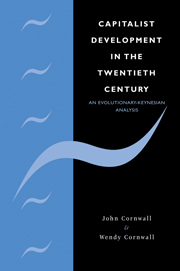Book contents
- Frontmatter
- Contents
- List of figures
- List of tables
- Foreword by David Colander
- Preface
- Part I Framework
- Part II Explaining the development record
- 8 Understanding the Great Depression
- 9 Foundations of the golden age
- 10 The golden age
- 11 Unemployment
- Part III Political control of the economy
- Bibliography
- Index
8 - Understanding the Great Depression
Published online by Cambridge University Press: 22 September 2009
- Frontmatter
- Contents
- List of figures
- List of tables
- Foreword by David Colander
- Preface
- Part I Framework
- Part II Explaining the development record
- 8 Understanding the Great Depression
- 9 Foundations of the golden age
- 10 The golden age
- 11 Unemployment
- Part III Political control of the economy
- Bibliography
- Index
Summary
Introduction
Chapter 6 outlined the framework for analysing historical processes in which institutional changes provided the causal linkages between episodes. Chapters 9 to 11 apply this framework to the historical record, showing it to be the appropriate formulation for modelling the post-World War II era. Historical events also suggest that, in an episode extending from the end of the nineteenth century to the end of the 1920s, performance-induced change in technology was the structural change linking this episode to the Great Depression of the 1930s. In this chapter, a technology version of our framework shows the linkages connecting the two episodes of the pre-World War II era.
The data available to support analysis of this period are more limited than we would like. In contrast to the post-World War II period, comparably defined data describing the macroeconomic records of the developed capitalist economies are scant for the earlier era, making reliance on the American record necessary. However, the severity of this shortcoming is reduced by the existence of transmission mechanisms in the 1930s, so that events in the United States were quickly felt in the rest of the developed capitalist world. Consequently, an explanation of the events of the 1930s in the United States also provides understanding of events in other economies.
- Type
- Chapter
- Information
- Capitalist Development in the Twentieth CenturyAn Evolutionary-Keynesian Analysis, pp. 132 - 155Publisher: Cambridge University PressPrint publication year: 2001

